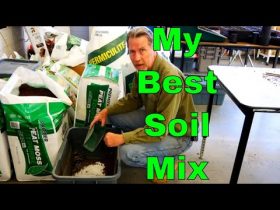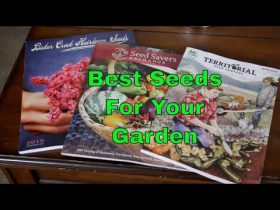He’s going to introduce you to 10 different plants that you can grow that are super-abundant and resilient for the Florida climate to help you grow a large amount of your food at home and be able to skip those trips to the grocery store. This doesn’t just apply to Florida, though. Semitropical climates exist around the world — the Caribbean, Central and South America, southeast Asia, parts of Africa, and parts of Australia, just to name some places, are all places where this can be a super-helpful article to you.
Pete: Alright, what’s up, guys? What’s growing on? Pete Kanaris here with Green Dreams and I’m coming at you from Tampa, Florida. I’m about 20 miles north of Tampa and we’re growing in a subtropical environment here, in 9B, and I’m taking over Rob Greenfield’s channel today.
I’m putting a video together for you all on our top 10 food crops to grow in a subtropical environment for self-sufficiency. These are the top 10 go-to food crops that are super-easy to grow. Something I’ll tell you guys is we focus on plants that thrive on neglect, that grow with ease. Most of these crops are perennial crops.
By perennial, I mean something that doesn’t need to be replanted every year, like you would an annual. This is plant it one time and typically forget it. Perennial crops are crops that live two or more years. The first one I want to talk to you guys about is actually right here, behind me, just over my left shoulder.
This is chaya, or tree spinach. You can see the big, giant leaves off of this tree. This is a really easy one to get established in your garden. This is one that I tell people about all the time and the first thing that scares them about this one is that it has to be cooked. Chaya does need to be cooked for about 10 minutes.
There’s an offgas of cyanide that comes off of there. You definitely don’t want to use an aluminum pot, but this is a big-time staple crop in Central America. This is a really easy one to propagate and start, so if you wanted to share this with your friends, you would simply take a cutting like this, stick it in the ground, take off the leaves, and it will start growing.
It’s really that easy. The leaves from this are actually quite delicious. I find this tree to be really, the flavor of the leaves to be hearty. They’re really filling. They go really well in a soup, really well in a dish. Also known as tree spinach. This is four times as nutritious as typical spinach and it wants to grow here.
It wants to grow here, through our hot summer, our humidity, and our full sun. The #2 plant I want to talk about that is a must-have for your garden is sitting here behind me. This is moringa oleifera. This one likes full sun. If you noticed, I had that chaya in a dappled light, understory situation.
This one wants to be out in full sun. I look at this tree as like having a health food store in your back yard. This one is like 22% protein, by weight; 68 different antioxidants; four times the calcium of milk. I could go off about all the different minerals and nutrients that are inside of this plant.
This one is literally one of the fastest growing trees we also have on the farm. Commercially, they grow these trees about a foot apart and they prune off the new growth every week. Most commonly, you would dry those leaves and powder them, but you could put this fresh into a salad. You could put this fresh into a smoothie.
You could eat this fresh, like this. The tree is also known as the horseradish tree. That’s because the leaves can be a little bit on the spicy side. I prefer this as a supplement. I prefer this in a smoothie. I find it to be a little bit on the strong side, but it grows so well and is so nutritious.
The powder from this tree goes for $30-40 — I remember when it was $60 a pound. So, super-nutritious. My #3 must-grow crop for Florida would be what Rob would like to call yucca or cassava or manihot. We got a lot of comments on that one from the videos we did together. This is a must-grow crop, a super easy to grow crop down here in Florida.
This is what they would make tapioca pudding from. Cassava is a root crop and it’s really easy to get started in the garden. It’s one that you literally, just like I showed you on the chaya, you take a cutting of, so probably something a little older than this. You want three nodes above and three nodes below the soil.
You just stick this guy in the ground and it’ll grow. Usually, cassava is about an 8-9 month crop. You’ll get a root crop off of that. I just did a specific video on cassava, on cooking it, on harvesting it, on growing select varieties, with my good friend, Josh, from Hart. If you want more detail on that, head over to my channel and you’ll see more specific stuff with Josh — how they cook it, how they prepare it.
I had cassava bread while I was there. There are many different ways to eat this. Cassava? Must grow it. The fourth crop I want to talk to you about today are sweet potatoes. Many people, when you think sweet potato, you think of that typical orange sweet potato, but there are hundreds of heirloom varieties of sweet potato.
There are white sweet potatoes, purple sweet potatoes, typical orange sweet potatoes, but what a lot of people don’t know is you can eat the leaves and the roots of a sweet potato. Sweet potatoes just happen to be one of the most nutritious crops in the world for that reason. What I really like to do is pull all of these young leaves off of here.
This isn’t a very good example of a sweet potato patch. I just have a couple of slips that we planted here maybe a month ago, that are starting to take over, but I can tell you, if I came back in this area in just a few weeks, this would be a solid sea of green. The leaves are just starting to fill in.
You would start sweet potatoes by buying just organic sweet potatoes at the grocery store, sticking them in some soil, letting the sprouts come off and you break those off and that’s what would be called a slip. If you don’t start it from a potato, you actually order slips in spring from a sweet potato company.
Like I said, there are many different varieties and types. Not only do you get this awesome potato at the end of the season, which is really fun to dig up, to pull them out of the ground. You don’t have to eat them right away. They can last 6-9 months inside of your house, but during that entire time, you can eat the leaves off the sweet potatoes.
So, sweet potatoes are super-exciting for me because I love the flavor of the greens. They’re great sauteed with just a little salt and pepper on them, make a great side dish, and then you get potatoes at the end of the season. Digging up sweet potatoes is one of my favorite events on the farm. My #5 favorite perennial vegetable to grow down here in the food forest is sisso spinach or Miami spinach.
This one makes a really nice ground cover. It can take full sun or dappled light. You can see I accidentally ripped a little bit of that root out. I can stick it back in the ground. It will easily grow. This is one that doesn’t need to be cooked. It can be eaten raw. It really has a nice texture to it, not too slimy, goes really great in a salad, goes really great just eating it fresh or in any type of dish.
This is a great perennial vegetable that I planted one time and it’s been here for multiple years, that’s here all summer long if I want to come outside and have something to add as a green in a salad or to a plate, so sisso spinach is definitely worth growing if you’re in a subtropical environment.
We’ve got one or two varieties of this one. It is just great. Like I said, it has a nice crunch to the leaf, it’s not too slimy. It makes a great perennial vegetable to add to your landscape, so #5. My #6 must-have for a sustainable garden in Florida is definitely going to be katuk. Katuk is an awesome perennial vegetable, super-high in protein, very similar to moringa, where it’s like 20% protein and it tastes delicious.
It literally tastes like raw peas. It’s one that really has a nice flavor raw. Kids like it. Everyone I’ve given it to is like, wow, that tasted pretty good. I have a variegated variety and a green variety. They both thrive on neglect. These plants never get watered. These plants never get fertilized.
There is no irrigation here. They live and thrive on neglect all year long. With a lot of these perennial vegetables — sisso spinach, moringa, katuk — that young growth, that new growth that’s coming off the top is going to be the most tender, the softest. So, as I work my way down the plant, these bottom leaves are going to be a little tougher.
They’re still great to eat. They can still go in a dish. Probably better in a cooked dish to break them down a little bit, but for eating fresh, I find the raw tips are always best. So, katuk? Grow it. My #6 food crop to grow here in Florida, which probably would not typically be looked at as a vegetable, is papaya.
Papaya was something that I really enjoyed, spending time with Rob. It’s something he commonly made in his dishes. I think my favorite was his Thai coconut curry with the papaya in it. I love green papaya. I think it’s great as a vegetable. I love papaya salad at a Thai restaurant and I love the flavor of a good, ripe papaya as a fruit.
Papayas don’t have to be eaten ripe; they can be eaten green, like a vegetable. We’re starting to get some little papayas here and you can get these while they get larger and they’re green, or you can wait until they get ripe and eat it as a fruit. This one doesn’t have a lot of fruit on it right now.
The other ones I have are tall and I need to cut them back. You can cut your papayas back every couple of years. One of my mentors, a guy I feature a lot on my channel, is Jim Kovaleski. He’s got a papaya tree in his front yard that’s 5-6 years old, so these trees can last a while. They can be perennial.
They can die back if you’re further north, but you can start them in your greenhouse and get them outside right after that last frost and potentially get a green fruit in six months, so papayas are worth growing. Find a good one, grow the seed. Easy to get started. Highly suggest growing it. #7, I’ve been really busy the last couple of weeks with the nursery business and all of my plants out in the ground for these last three have been cut down for cuttings and propagation, so I’m over here, in the nursery, where I have some better examples.
What I want to talk to you about now is edible leaf hibiscus. That’s this big-leafed plant behind me. This can be used as a wrap. It can be eaten raw, chopped up in a salad, be used as a green. This is one that might be a little bit more on the mucilaginous side, maybe slightly slimy, some would say.
That’s really good for lining our insides. This variety is actually less slimy than the variety I have over here, on this side. This one definitely has a little bit more mucilaginous to it. I have a couple of different varieties. I have this skinny-leafed variety. I have this fat-leafed variety.
There are a couple of different names for this one. I like to just call it lettuce leaf hibiscus. I really like this one as a wrap. If you wanted a green wrap, something that’s gluten-free, you can grow this for your wrap. The #9 must-have for the sustainable garden in Florida, this is one that the kids really like: cranberry hibiscus.
The leaves are beautiful, nice deep red. Some people call that like a mahogany. These are sweet. They’re sour. They’re delicious just raw. They go nice in a salad, if you chop them up. My favorite thing to do is, if I’m making a sandwich or packing something for the day, I’m going to be on the road, I come out and get a handful of fresh leaves and, just like I talked about with the katuk, the younger leaves, the fresh growth, like this is a really fresh red one.
You can see this is an older leaf. You can see a color difference. You see how that one is pale and that one is dark red? The younger growth is always going to be the most tender and the sweetest. Nothing wrong with the old growth; it’s just not going to be the best, flavor-wise. So, cranberry hibiscus is not only a stunner in the landscape, a pretty-looking plant, but it has a really nice edible factor and I guarantee if you give it to one of the kids, they’re going to enjoy it too.
This one has been a perennial here. It will set flowers. All hibiscuses have edible flowers. You can eat the flower on this, but after it’s done setting a flower, it’s going to set seed that you could save to replant if you’re in a more northern type climate. So, cranberry hibiscus is another must-have.
If you’re into gardening down here, in Florida, and you don’t have it, this is one to add to your system. Last, but not least, must-have perennial for a sustainable garden in Florida or in any subtropical climate is Okinawan spinach. This is one that we’ve been propagating really hard the last few weeks.
This is also one that the squirrels like, that I have a hard time keeping going in the beds, but I really like the flavor of it. It’s really nice to eat raw. It’s nice to eat cooked. It’s nice to put in a dish. It’s very similar to the longevity spinach, which is right here, behind me, but I think the longevity spinach is a little stronger, a little more like a medicine.
The squirrels don’t like it as much, so it grows here a lot better. I’ve noticed that we plant these two for clients all the time, longevity spinach and Okinawan spinach. The Okinawan is a little prettier. It’s got some purplish-red to the underside of the leaves. It’s hit or miss. Sometimes the Okinawan does better on your site, sometimes the longevity does better on your site.
I would say both of these are a tie for #10, but this one tastes a little better. I hope you guys enjoyed this video. Thank you, Rob, for the opportunity. It’s been a blast. I can’t wait to work with you again. I can’t wait for your next challenge. I can’t wait for you to get back to Florida so we can do some fun stuff.
Thank you guys so much for following. What we like to do around here is pound dirt! Rob: I hope you got a lot of inspiration and education out of this time with Pete. He is a wealth of knowledge. He is an expert in growing food and he helps a lot of people to do this, both in person and through his YouTube channel.
Make sure to subscribe to his channel. The links to follow him are in the description. If you got a lot out of this video, make sure to subscribe to this channel as well, where I’ll have many more guests to come, as well as videos led by me. Also, share this, comment, and like it to spread it out into the world and get this information out there to people who need it, but don’t know it’s there.
I love you all very much and I’ll see you again real soon. Subtitles by the Amara.










Leave a Reply